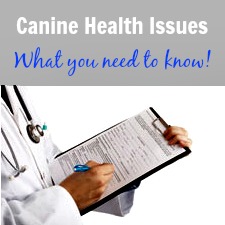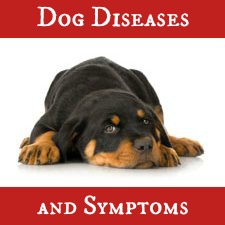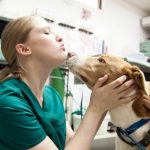
Panosteitis is the correct name for what is often called ‘puppy growing pains’. It’s most often seen in large and giant breed puppies who are between 6 and 18 months old. Male puppies are up to 4 times more likely to suffer from this canine bone condition than female pups.
In This Article You Will Read About
The symptoms usually ‘come and go’ and may last for a month or two, or six (or even a year or more). BUT, on average, a pup will only experience (acute) symptoms for around 2 to 3 months.
The classic pano growing pains are caused by inflammation in the rapidly-developing long bones of a pup’s legs – most often in the front legs, and around the growth plates. It’s often referred to as a ‘spontaneous and self-limiting’ condition.
Basically what this means is that the inflammation and pain appear without any obvious ‘trigger event’ or underlying illness, and disappear of their own accord after the disease has ‘run its course’.
Many experts can’t agree about what actually causes the inflammation and joint pain, but it is a real condition and a fairly common one.
Certain Breeds Are More Likely To Suffer From Pano
Panosteitis is usually seen in large-breed pups, but some breeds are more likely to develop it than others.
These include:
- Basset Hounds
- Doberman Pinschers
- German Shepherds
- German Shorthaired Pointers
- Great Danes
- Golden Retrievers
- Irish Setters
- Labrador Retrievers
- Rottweilers
- Saint Bernards
Although the above breeds are more likely to develop growing pains, any large or giant breed pup is at risk, as are large or extra-large mixed breed puppies (many of whom will have one, if not more, of the breeds listed in their family tree).
What Causes Panosteitis?
Pano can appear out of the blue, and usually does. Most often there’s no obvious reason for it either.
However, veterinarians and researchers have several theories about what causes Panosteitis. These include:
- Bacterial infection
- Viral infection
- Hormone imbalance
- Metabolic disorders
- Dietary or nutritional deficiencies or excesses
- Genetics (a hereditary component)
The inflammation which causes the pain of Pano could be caused by any one, or combination of several, of these factors.
Research is still being done to try to get more information and a definitive answer to this question.
What happens inside the bone?
Panosteitis actually involves structural changes inside the long bones. With this condition, the fatty fraction of the bone marrow is replaced with fibrous tissue.
The changes continue and the new fibrous tissue is replaced with a woven bone. Woven bone is shown as fluffy opacities on an x-ray image.
This remodeling inside the bone due to unexplained reasons turns in reverse and gets the bone marrow the way used to be – when it’s normal the symptoms stop.
The Symptoms of Panosteitis in Puppies
Symptoms of this condition are classic puppy growing pains. They usually appear suddenly and out of nowhere with no injury or apparent cause.
The most common symptom of Panosteitis is limping or lameness.
Limping and lameness are usually intermittent, last anywhere between a day and two weeks, and may affect one, two, or all your pups’ legs at one time or another.
There is mild discomfort or pain accompanying this lameness or limping. It’s more noticeable when your pup has been sitting or lying down in one position for a long time and gets up or starts to move around.
Limping may be more severe after exercise too, and your pup may show a lowered level of activity and even seem ‘lazy’ at times.
Sometimes there is swelling of the leg joints which can be spotted by the owners.
In canine Pano, the most painful area of the bone is usually the center (midway between joints), rather than the joint itself or the extremity of the limb.
Symptoms of Panosteitis that appear sporadically can include:
- Low-grade fever
- Loss of appetite
- Lethargy
- Enlarged tonsils
- Raised white blood cell count (response to inflammation/infection)
- Reduced muscle mass in legs
Your veterinarian can make a diagnosis of Panosteitis from the symptoms you describe, a hands-on exam of your pup, and X-rays which should show signs of changes to the bones caused by this condition.
Pano in dogs can come and go in episodes. In most cases, the episodes don’t last longer than 3 weeks. In case the lameness persists for 5 or more weeks you should have your puppy re-checked for an additional bone disorder.
Check this article for more information on the symptoms.
Diagnosis of Panosteitis
Your veterinarian can make a diagnosis of Panosteitis from the symptoms you describe, a hands-on exam of your pup, and X-rays which should show signs of changes to the bones caused by this condition.
An integral part of the physical examination is to touch and firmly press the long bones of the affected leg at the middle of the shaft. The goal is to see whether this act produces pain and thus read the dog’s reaction.
Excluding other possible conditions and injuries makes diagnosing Panosteitis a pretty easy task for any experienced veterinarian.
Panosteitis Treatment
Although it’s painful and can last for quite a long time, Panosteitis in puppies is almost always a self-limiting condition – in other words, it gets better by itself eventually!
Luckily there are also generally no long-term effects.
But, there are things that you can do to help your puppy feel more comfortable while he’s experiencing these growing pains.
Medications
Anti-inflammatory medications and corticosteroids can help reduce swelling and inflammation.
In some cases pain medication for dogs such as Rimadyl may be prescribed. Painkillers such as Aspirin are also often used to treat Pano in puppies and reduce discomfort.
Other NSAIDs, including Meloxicam, provide fast pain relief and provide the dog with temporary comfort.
However, only give your puppy medication that has been prescribed or recommended by your vet. Never try to medicate with human products such as Advil or Tylenol as these are dangerous for your pup, and can even be fatal.
To learn more about the safe usage and possible side-effects of giving Aspirin to your Rottweiler check out this webpage: Aspirin for Dogs.
Rest
Your Rottweiler puppy, or whatever breed you own, needs plenty of rest to help his bones heal. It’s a good idea to reduce his exercise levels and don’t allow him to put too much stress on his growing bones/joints as that will only make the situation worse.
Diet
Making sure that you feed your large breed puppy a food that is specifically formulated for his unique dietary requirements can help to reduce bone and joint problems such as Panosteitis.
The Right Level of Protein
For pups with Pano, you really want dog food on the lower end of the protein scale. Don’t overfeed your dog because an excess of protein seems to make things worse. This is a very important element of puppy care with large and giant breeds!
On the other hand, it’s an even bigger mistake if your large breed puppy eats food with protein and calcium levels below the daily requirements (ex. feeding him adult dog food).
These are puppies that grow rapidly and need higher levels of energy coming from the food. Too few proteins and calcium in the food will result in weak bones and growth impairment.
Make Sure the Food You Choose is Specific to Your Dog Breed
That’s why you need to find the perfect feeding balance and do your research on the topic. Specifically formulated commercial food for your dog is the best option.
The quantity you give him should be according to the recommendations based on age and weight. Your veterinarian can always give you suggestions and tips on how to feed your puppy properly.
Check out our guide to the best large breed puppy food for more information on what you need to look for, including our recommendations.
Is Pano dangerous and what should a Dog Owner do?
Panosteitis in dogs is not considered to be a very serious disease. It is one of the most common reasons for lameness in your dogs, but there are other more serious conditions that can cause the same type of lameness.
Even if your dog qualifies as a possible candidate for Pano and starts showing recognizable symptoms during young age, you can never be sure if that’s the single reason for lameness.
Sudden onset of such symptoms can mean something much more serious can be happening. Just in case, take your dog to the vet and have him checked out. Once you find out the pup has Panosteitis and your dog will outgrow it eventually you can put your mind at ease.
Other bone diseases in growing dogs
Rapidly growing puppies can suffer from osteochondritis dissecans. If your puppy has this condition it means that the cartilage at the end of some of his bones develops abnormally. The most commonly affected joints are the shoulder, the hip, the elbow, and the knee.
Hypertrophic osteodystrophy is an inflammation of the growth planes of the long bones and manifests with fever and pain in the joints. Usually, the HOD is a self-limiting condition (just like Pano) and leaves no permanent damage.
Elbow and hip dysplasia in puppies are due to abnormal anatomical configuration of the muscles and the bones. The structures in the hip or the elbow aren’t properly aligned so the joints become inflamed and painful.
One more bone condition in growing puppies is luxation of the patella (the knee cap). Opposed to Pano, patella luxation is primarily a problem in small breeds of dogs and is a hereditary condition. Sometimes it resolves by itself, but sometimes a surgical correction is required.
Conclusion
If you have a dog that is predisposed to Pano you should get really familiar with the symptoms and the age when they are most likely to appear. Make use of your vet’s knowledge and discuss the preventative measures that are best for your dog.
Your dog deserves to live a happy and pain-free life so act fast and ask professional help whenever something is not okay – you owe it to him!
Rottie owner? Get your Rottie featured on our site with a dedicated page
Simply fill out the form in the link with a picture and description and we’ll create a dedicated page on our site featuring your Rottie.




